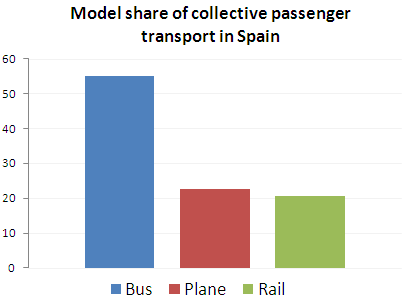|
In March 2011, one month prior to the EU’s adoption of the White Paper on the Future of Transport Policy, the Spanish Council of Ministers adopted a comprehensive Strategy for Energy Saving and Energy Efficiency (Estrategia de Ahorro y Eficiencia Energética, EAEE), supported by an awareness campaign on the importance of energy saving. The strategy, which focuses in three main fields: transport and mobility, construction and lighting and electricity consumption, will allow an annual reduction of 12.5 million tonnes of CO2 emissions.
Bus is the most utilised mode of collective transport in Spain and a principle actor in the Strategy of sustainable mobility. Buses and coaches in Spain carry more than 1.8 billion passengers per year and cover 67% of all journeys realised by collective transport per passenger kilometres – more than double the plane (22.5%) or the railway (20.5%).

A policy to promote the use of buses in Spain will shift 10% of private car users into bus passengers and reduce CO2 emission by 4 million tonnes. If 10% of private car journeys made in Spain are shifted to bus and coach, it would save 770 million litres of fuel or the equivalent of 37% of the saving target of the entire transport sector and 16% of the global aim stipulated in the EAEE. This would contribute to reaching the global annual objective of CO2 reduction for all sectors by 11%.
In times of budget austerity and fuel price increases, it is reasonable that transport policies be redirected towards the bus as the most efficient mode of transport in terms energy use and affordable cost of infrastructure.
Encouraging people to switch from private car to public transport would require investments into dedicated infrastructure and significant improvements in service quality, such as Bus Rapid Transit, terminals and modal hubs.
Source : ASINTRA’s Semanal Digital, Num. 381
|














